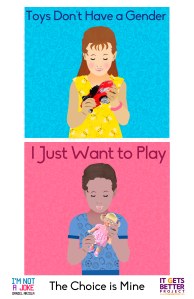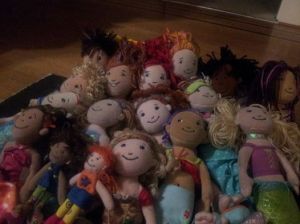
Image by artist Daniel Arzola for the It Gets Better Project. Used with permission.
“May the fourth be with you!” my son and I solemnly greeted each other this past Sunday, May 4th, and then instantly broke into giggles at the play on pop-culture.
Grade one and our six year-old has been bitten by the Star Wars bug, just like my little brother who was about that age when George Lucas’ seminal film was released in 1977. Over thirty-five years later, our son returned to school this past fall newly obsessed with anything related to the Force: LEGO Star Wars, Angry Birds Star Wars, and, of course, the real Star Wars. We watched the first movie together last summer – “Episode four,” our son is quick to correct me, but always the “first” for those of us who were around in the seventies. Amanda and I had to hold his hands through the scary bits, but that didn’t put him off – he was hooked.
We subsequently screened all the other episodes together as a family, both the original and the new trilogy. During our visit to my parents in Ottawa last summer, my mom retrieved my brother’s long-forgotten Star Wars action figures from the depths of the basement crawl space. Our son played with the vintage toys, entranced. “Has he left the basement yet?” my brother enquired a few days later, on Facebook. I suspect my brother was secretly jealous.
By happy coincidence, the interactive Star Wars Identities Exhibit was on in Ottawa during our stay. We led our awe-struck boy through displays of original artefacts from the film, and photographed him next to the real R2D2 and C3PO. Through a series of interactive prompts, we created identities for our very own, unique Star Wars heroes, whom we whimsically named Chewbuku (Wookiee), Thorax (Twi’Lek) and Schmoo (Ewok).
When school started a few weeks later, our son headed back, proudly toting his brand-new metal Star Wars lunchbox, a souvenir from the exhibit. At least he won’t be razzed this year, I’d thought to myself. Some kids in kindergarten had given him a hard time about his Thomas the Tank lunchbox the year before.
“Thomas is for babies,” they’d taunted, causing him sudden doubt and shame about his lifelong passion for trains. We’d talked him through this – you like whatever you like; there’s no age limit on liking trains; even Mommy still likes trains… He continued to play with his tracks at home, but had quickly learned to keep this interest to himself. Star Wars, on the other hand, had a certain cachet. It was perennially cool. I’d even spied a couple of other kids in his kindergarten class with Star Wars gear, so I knew he’d be good to go.
But only the second week into school, our son came home in tears: “People were making fun of my lunchbox!”
What?!
Turns out some boys in his class had asked him to identify his favourite Star Wars character. Without missing a beat, he’d piped up: “Princess Leia.”
“I like Luke and R2D2 and Han and Obi-Wan, too,” he explained to me and Amanda, afterwards – in fact, he’d go on to dress up as a young Obi-Wan Kenobi for Hallowe’en – “But Princess Leia is my favourite. So is Princess Amidala.”
The boys had dissolved into laughter. “Oooo!” they’d taunted. “You like princesses!” They proceeded to mock the Leia image on his lunchbox: “You like girl things!” Never mind that she was there alongside Luke Skywalker and Han Solo.
Our son was hurt and confused. What was there not to like about Princess Leia? She was tough, strong, smart, and beautiful. The notion of splitting the world into “girl things” and “boy things” was completely foreign to him. He’s grown up with two moms in a household where people are who they are and like what they like, regardless of gender. We’ve always encouraged his interests, which currently range from Star Wars, Trashies and Angry Birds, to Littlest Pet Shop, Groovy Girls, and Rainbow Magic fairies. At our house, toys are just toys.
Thankfully, the lunch monitors had run to get the teacher, who’d intervened with the boys and reassured our teary son. That afternoon, she’d initiated a positive, upbeat discussion with the class about the kids’ passions and interests, pointing out how much they all had in common in spite of their differences, and gently reframing their thinking about “girl things” and “boy things,” as well as “girl colours” and “boy colours.” We were so relieved that she not only understood and supported our son, but also was willing to seize the teachable moment with the entire class.
Still, the incident left me and Amanda deeply unsettled. We were only two weeks into grade one, and already our son was being singled out and picked on because he doesn’t conform to prescribed gender roles. We were shocked and saddened that most of the six year-olds in our son’s class had already assimilated the old-school message that toys, colours, movies, heroes, you name it, are gendered. Of course, society continues to perpetuate this message every single day. Just walk into any kids’ clothing store and face the great divide between the pinky-purple frills of the girls’ section and the rough-and-tumble blue, grey and blacks of the boys’.
Nevertheless, some of these kids must also be getting this message from home, whether overtly or covertly. Our son has grown up in this same world, after all, with the same societal messages, and yet he has no sense of being limited by categories and labels. And yes, we’re proud that we’ve managed to raise him this way, to be so free and open-minded and quintessentially himself. But at the same time, we can’t help but worry that we’ve set him up to be bullied. As if having two moms isn’t difference enough to contend with. In fact, we worry that “having too moms” may be mistakenly seen by others as the cause of our son’s gender-neutrality, as though simply being raised by queers has somehow “turned him” into a gentle boy who likes so-called “girly things.”
Which is why, at parent-teacher interviews a few months later, I immediately tensed when our son’s teacher casually remarked that our son has different interests than most other boys his age. She went on to give an example from that past week, when he’d talked in class about a movie he’d recently seen.
I nodded, glancing over at Amanda, a knot of dread forming in my stomach. The film was none other than Ariel, the little mermaid. Our son had picked out the DVD himself at the video store on Saturday. We’d had pizza and watched it together as a family. He’d been entranced by Ariel’s character, her long, flowing, red hair, and her swishy mermaid tail. It hadn’t occurred to me that he would go to school on Monday and blab all about it – but then again, why wouldn’t he? And more to the point, why shouldn’t he?
Sure enough, his teacher confirmed, he’d gushed on about it at circle time, and all the boys in the class had started to snicker. She was simply sharing the facts – not making a judgement – but Amanda and I nevertheless went on the defensive. We tried to explain:
“This is just who he is. He may have two moms and no male role models at home, but he’s always been his own person.”
“A gentle, sensitive boy.”
“He likes what he likes.”
“He chose that movie himself.”
“We just try to encourage and support his interests.”
In other words, it’s not because we’re lesbians.
His teacher just nodded and smiled. She wholeheartedly agreed that our son is his own person. She went on to reassure us that she doesn’t want to see him change – that it’s the attitude of the other kids that needs to be changed. She explained that she’d just ordered some storybooks that openly challenge the notion of gender labels, in order to continue the conversation in class. And that she’d turned the snickers about Ariel around by asking who else had seen the movie, and by telling the kids that she’d watched that film a lot herself, growing up, because her younger brother was really into it. This had provided a safe opening for other boys in the class to admit they’d seen the movie too, usually with their sisters, and to concede that it was actually a pretty good story.
We couldn’t believe our good fortune. Here we were, only our second year in the school system, with a teacher who not only “got” our son, but also was willing to advocate on his behalf. A teacher who also understood and respected us as a queer family.
As the school year moves on, our son has been finding his own way. He’s got a solid group of friends, most of them girls, but a few boys too. Most importantly, he’s surrounded by a posse of kids who like him for who he is and who will stand up for him if anyone’s giving him a hard time. The teasing, as far as we can tell, has pretty much stopped.
Still, I held my breath on “Bring a Toy to School Day,” the class’ reward for good behaviour the last day before Spring Break. I knew before even asking our son that he’d want to bring in some of his Groovy Girls, his latest passion, and had to actively fight my urge to talk him out of it. I watched him go into the school that morning, proudly clutching his three fashion dolls to his chest, silently praying that he wouldn’t get picked on. To my relief, the day went relatively well. A couple of the boys had made disparaging remarks and chased him at recess, but he’d handled it. Overall, he was more focused on telling me about the good time he’d had playing dolls with his friends, and how he’d been able to share his Groovy Girls with a few of the kids who’d forgotten to bring in a toy.
As for the boys who’d chased after him, he said, “They still don’t get that there’s no such thing as girl things and boy things.” And we agreed that they were missing out, big time, on a whole lot of fun.


Sara — what a thoughtful, gripping, and helpful essay.
“Girl thing” and “boy thing” issues have been troubling me recently, and this essay gave me new insight into the whole matter. When I shop for clothes and toys for friends’ children, I cannot help being shocked by all the fluffy pink princess and cupcake stuff for girls, as opposed to the adventure/professional stuff for boys (e.g. onesies with astronaut themes, as opposed to poodles). I’m grateful to my mother for noticing early on I wasn’t interested in dolls but in books and for nurturing my interest in the latter, and for taking it as completely unremarkable when one of my brother’s favourite stuffed animals was a “girl” named Florence the Frog. Perhaps her doing so was one reason why this same brother “got” the “genderless/unisex” idea very early, when he made a pet of a snail and gave it the name “Leslie,” which he had been told could be a boy’s or a girl’s.
I’m very glad to hear the teachers at your son’s school responded in such a supportive way.
Love this! He sounds great. At waldorf school the boys in kindergarten participate in being a doll day.
Another great make-you-think post!!! Thank you